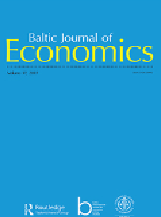Randomness or stock–flow: which mechanism describes labour market matching in Poland?
Randomness or stock–flow: which mechanism describes labour market matching in Poland?
Author(s): Ewa Gałecka-BurdziakSubject(s): Economy, Labor relations, Financial Markets
Published by: BICEPS/SSE Riga
Keywords: Stock–flow matching; random matching; job queuing; Polish labour market; temporal aggregation;
Summary/Abstract: I identify which theoretical model (random, stock–flow, or job queuing) best describes the matching mechanism in the labour market in Poland. The purpose of this work is to formulate policy recommendations aimed at increasing the number of matches. I use monthly registered unemployment data for the period January 1999–June 2013 and econometrically correct for temporal aggregation bias in the data. I extend known solutions and apply them directly to a job queuing model. Job seekers (from the pool) seek work among old and new job posts, but only a small fraction of the newly unemployed individuals find work quickly. Vacancies are the driving force in aggregate hiring, but the inflow is more important than the stock. The random model has greater explanatory power, although the results do not negate the non-random model. Hence, better information and higher inflows (especially of job offers) should facilitate matching.
Journal: Baltic Journal of Economics
- Issue Year: 17/2017
- Issue No: 2
- Page Range: 119-135
- Page Count: 17
- Language: English

